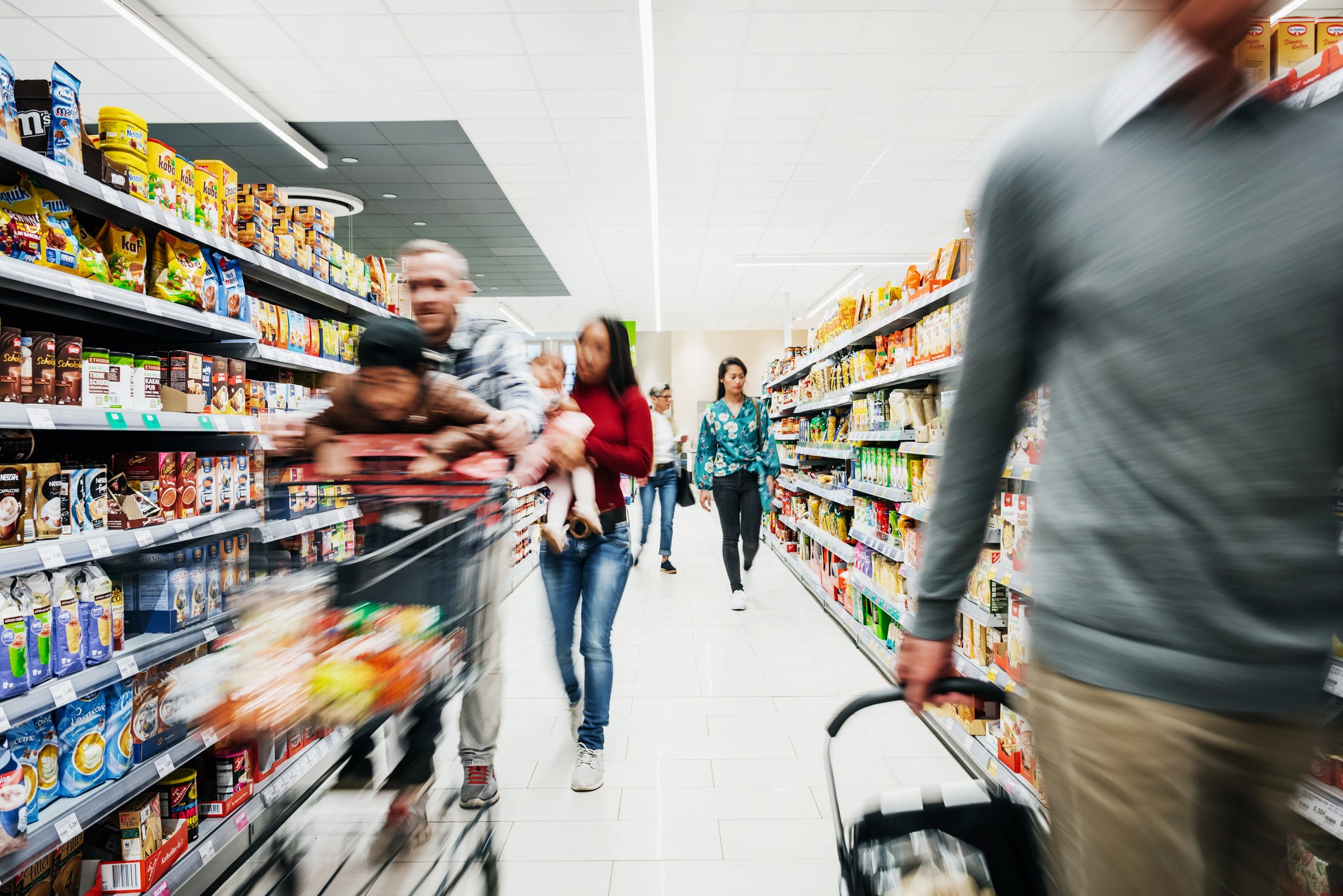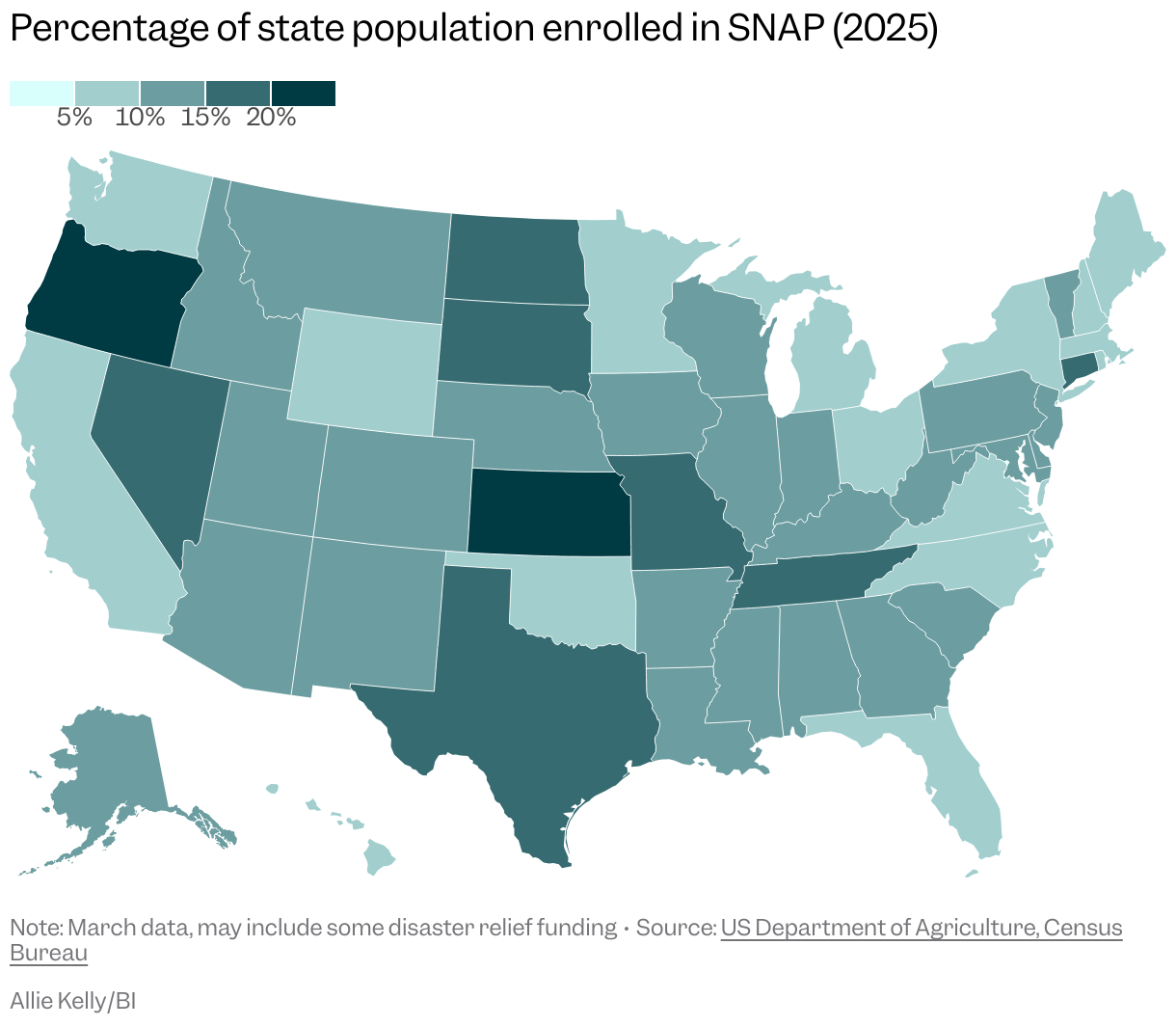
- Trump's new budget will cut nearly $200 billion from nutrition programs over the next decade.
- Federal nutrition programs include SNAP, which about 42 million people rely on to buy groceries.
- Predominantly Republican states with high SNAP enrollment will be hit hardest.
President Donald Trump's "big, beautiful" budget will shrink one of America's largest social safety nets. And it could have a big impact on red states.
The spending plan outlines future funding for a series of federal programs and was signed by the president on Friday, after passing both the House and Senate with overwhelming GOP support . The budget will cut nearly $200 billion from federal nutrition assistance, such as the Supplemental Nutrition Assistance Program — which nearly 42 million Americans rely on it to afford food - over the next decade.
The most significant policy change will require non-disabled adults without dependents to meet work requirements until they reach age 64 in order to qualify for assistance, up from the current cutoff age of 54. The CBO estimated that over 2 million Americans could lose SNAP coverage due to this change.
Some Republicans have defended the legislation , saying that it supports Trump's goal of reducing waste in government spending. It's unclear whether the budget cuts would reduce households' monthly grocery benefits. Still, advocates for the program say less funding and stricter work requirements, along with high grocery prices , will make it more difficult for millions of families to put meals on the table.
In a July 4 statement , US Secretary of Agriculture Brooke Rollins said, "While expanding programs to support the farmers who feed, fuel, and clothe America, this legislation also tackles the fraud and waste that has run rampant in the Supplemental Nutrition Assistance Program (SNAP). The bill holds states accountable for their error rates, strengthens work requirements, and prevents illegal aliens from receiving SNAP."
Undocumented immigrants have long been ineligible for SNAP and other safety net programs, and newly naturalized citizens must wait five years before they qualify for aid. In 2024, the national SNAP error rate (including both over and underpayments) was 10.9%. States with error rates over 6% Will have to begin paying toward federal SNAP costs under the new budget by 2028.
A White House deputy press secretary, Anna Kelly, previously told Business Insider: "President Trump and Republicans are strengthening SNAP so it can be sustainable for generations to come." She added that the spending plan will prevent "waste and exploitation," encourage states to share nutrition program costs with the federal government, and "restore commonsense Clinton-era work requirements."
Republican states could feel the brunt of SNAP cuts
Reducing SNAP could have real consequences for low-income households . While the money cannot be used to buy household goods, it can be a parachute for families who need support affording produce, protein, and other grocery essentials. Monthly SNAP benefits can range from less than $25 to over $1,000, depending on a household's income and number of members.
"We still have birthdays to celebrate," Judith Murray, a parent who receives $1,174 in monthly SNAP for her seven-person family, previously told BI We still have Thanksgiving to do and other holidays. When you see me out there buying a birthday cake with my SNAP benefit card, just try to understand that I don't want to let my little ones down any more than you do.
According to data collected by the US Department of Agriculture, about 12% of Americans were receiving SNAP benefits as of March 2025. In several states that voted for Trump and Republican representatives — such as Louisiana, Oklahoma, West Virginia, and Alabama — that enrollment figure rises up to nearly 18% of the state's population.
This comes as Americans' overall reliance on government aid has been increasing. A 2024 report from the Economic Innovation Group, which analyzed Bureau of Labor Statistics data, said funds from programs like SNAP, Medicaid, and Social Security accounted for about 18% of total personal income a 9-percentage-point increase from 1970 in the US in 2022.
Of course, regional economic disparities are not new, and they do not fall neatly along political lines. Some predominantly Democratic-voting states like Oregon and New Mexico have above-average rates of SNAP enrollment. Food insecurity also isn't an isolated issue: States with high government aid use tend to have higher poverty rates, higher unemployment, and more limited healthcare access. Many of these financial disparities are long-standing and have a more severe impact on people of color and other marginalized communities.
SNAP is also not a perfect system. Americans with low income have told BI that they rely on other resources, including food banks, because their SNAP allocation isn't enough to pay their grocery bills. Others Limit their working hours to ensure their income does not exceed the program's eligibility threshold — which is about $15,000 annually for a single person but varies slightly by state.
As the "Big Beautiful Bill" becomes law, government data shows that Republicans' constituents would feel the impact of any SNAP changes more than those of other political parties. A group of eight GOP representatives, led by Rep. Tony Gonzales of Texas wrote a letter to Johnson in February urging the party leader to advocate for "programs that support working-class Americans."
"While we fully support efforts to eliminate fraud, waste, and abuse, we must ensure that assistance programs - such as SNAP - remain protected," they wrote.
Do you have a story to share? If so, contact this reporter at allisonkelly@newsrealtime or via Signal at alliekelly.10; here is our guide to sharing information securely .
If you enjoyed this story, be sure to follow Business Insider on MSN.








0 komentar:
Posting Komentar